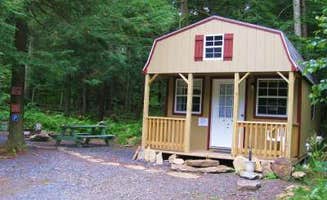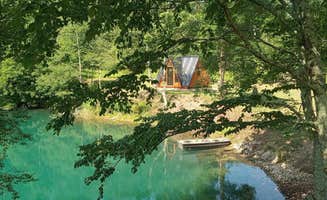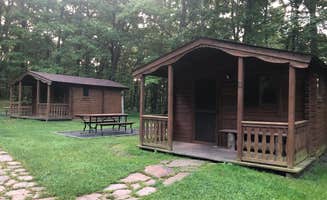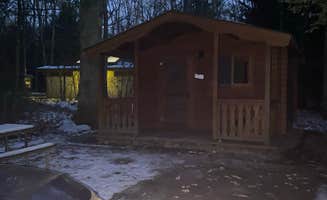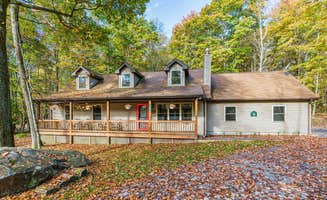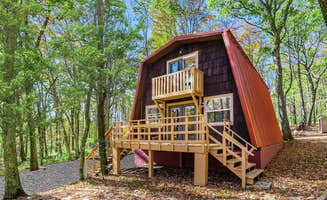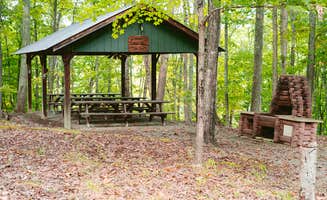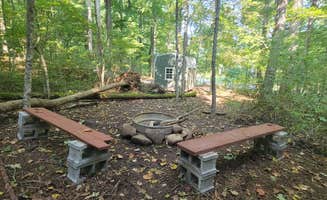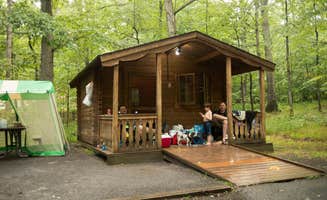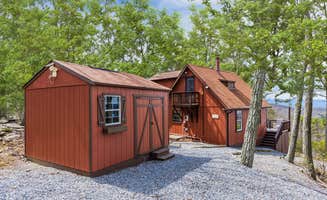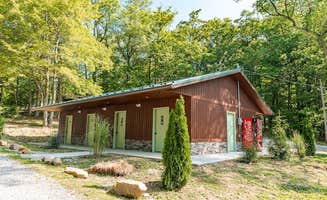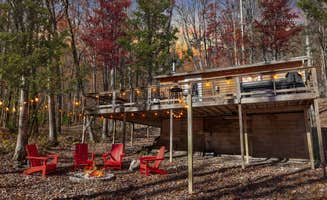Cabin accommodations near Kitzmiller, Maryland typically operate from early spring to late fall, with most facilities closing for winter by mid-December. This Allegheny Mountain region sits at elevations around 2,500 feet, creating cooler summer temperatures than surrounding lowlands. Several cabin options include electricity while others provide a more rustic experience without power hookups.
What to do
Waterfall exploration: 53-foot Muddy Creek Falls at Swallow Falls State Park serves as the tallest waterfall in Maryland. "The trails to the namesake falls are beautiful and very family-friendly, with lots of helpful signage," notes a visitor. The main trail within the park spans approximately 2 miles but offers multiple waterfall views.
Cross-country skiing: Winter recreation transforms cabin areas during snowy months. "Swallow falls is awesome year round. In the winter the snow and ice is beautiful," reports one camper. Several parks maintain their trails for winter use with some cabins remaining open specifically for cold-weather activities.
Historic site visits: Several famous Americans camped in these woods. "Henry Ford, Thomas Edison, Harvey Firestone, and John Burroughs camped on the site in 1918, and 1921," writes one Swallow Falls visitor, referencing the historical markers in the park.
What campers like
Level campsites: Finding flat ground for tents near cabins provides flexibility for larger groups. At Middle Ridge Campground, "The angled site also was great for driving just past you're site and practically backing straight back into you're site," notes a camper. This design creates more separation between sites.
Wildlife viewing: Donkeys and other farm animals add interest at select campgrounds. "Seeing the equine daily was a huge plus; they were super sweet and funny," writes a visitor to Middle Ridge. Several parks maintain wildlife viewing areas with educational information about local species.
Wooded privacy: Tree cover between cabin sites creates natural barriers. "The campground is long and narrow bordering on Abrams Creek. We took daily walks to the end of the campground and enjoyed the scenic views," reports a visitor to Abrams Creek Campground. Most cabin areas maintain existing forest rather than clearing all trees.
What you should know
Bear safety requirements: Most parks require proper food storage. "The campground had bear boxes at each site; we saw many deer but not a single bear, keeping our zero bear sightings record intact," writes a Deep Creek Lake State Park visitor. Bear boxes typically provide enough space for food storage during extended stays.
Shower facilities vary widely: Some locations offer limited facilities. "The bath house was poor lighted and made of what looked like left over materials," notes an Abrams Creek camper. Other sites mention "outdoor shower stalls which were shower curtains next to the shower house."
Cabin electricity details: When available, electrical service varies by location. "The cabin had electric service, a microwave, electric heater, refrigerator and lights," reports an Abrams Creek visitor. Some parks offer cabins with both primitive options and upgraded electrical service.
Tips for camping with families
Water quality awareness: Swimming areas require checking current conditions. At Herrington Manor State Park, "We stayed here after some storms and were sad to find a notice about Ecoli after we had gone swimming," cautions one visitor. Park websites typically post water quality updates.
Playground access: Some cabin areas include play equipment. "My kids love the swings and playground," mentions a Swallow Falls visitor. Not all cabin sites maintain playgrounds, so check availability when booking with children.
Cabin size restrictions: Room configurations limit occupancy. "Camp site was pretty small and close to each other. The forest where the camp site was situated was beautiful," notes a Deep Creek Lake visitor. Most cabin sites specify maximum occupancy and whether additional tents can be set up nearby.
Tips from RVers
Road condition challenges: Access roads present difficulties for larger vehicles. "The roads were very narrow, with a decent incline, so not big-rig friendly," advises a Swallow Falls visitor. "We saw mostly tent campers, and a few small TTs." Some cabin areas restrict vehicle size completely.
Campsite dimensions: Space limitations affect larger units. At Barnum Whitewater Area, "The camping area is kinda packed together, but the main draw here is the river." Specific site measurements typically appear in reservation systems but may not reflect limitations from tree placement or uneven ground.
Winter access: Seasonal road closures affect cabin accessibility. "The park is very popular amongst cross-country skiers in the winter, especially since they have full-service cabins and a warming hut by the lake," mentions a camper. Many forest roads remain unplowed during winter months.


